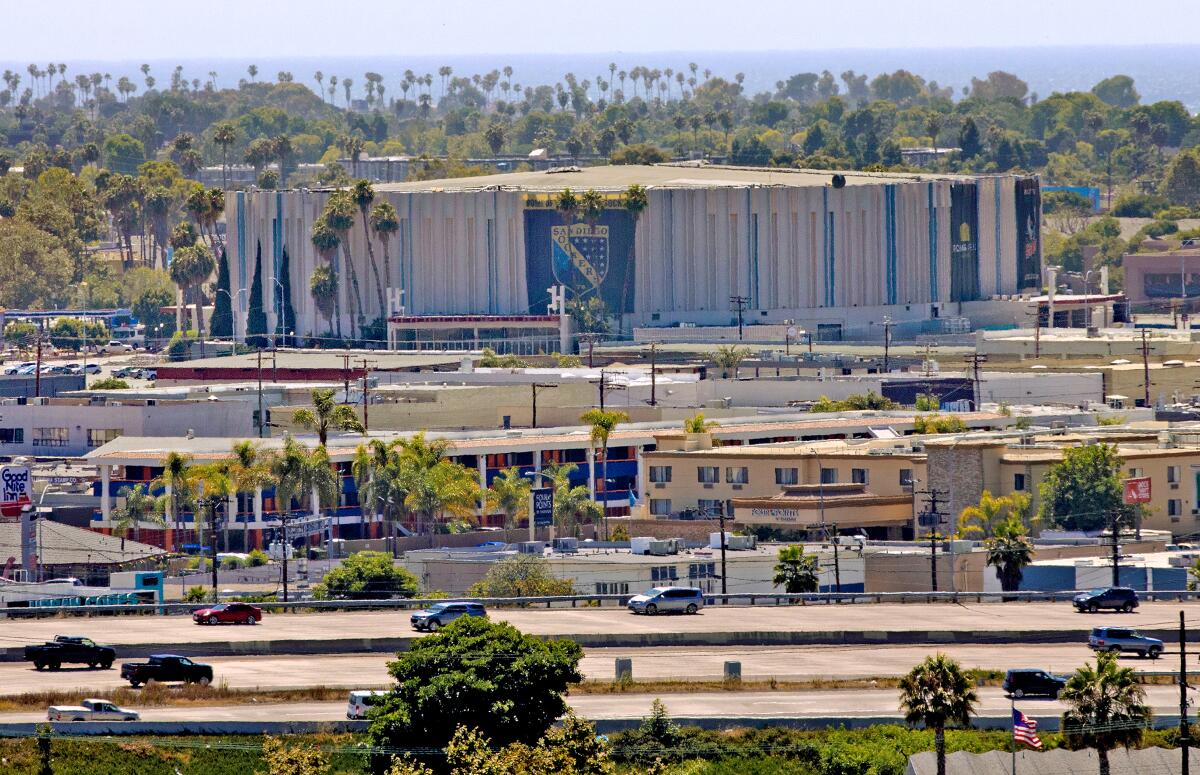The battle over Midway District building heights may be decided in court

Likely ballot-box victory introduces a new wrinkle in the form of an environmental lawsuit that could take months or years to resolve
Despite what appears to be a ballot-box victory for Measure E, a judge may get the final say in determining whether the Midway District can be stripped from the city’s coastal zone.
San Diego voters, according to returns tabulated thus far by the Registrar of Voters, appeared to OK the proposal to allow taller buildings in the 1,324-acre area sandwiched between the freeway, airport, San Diego River and Point Loma. If ultimately successful, the measure will strike the Midway District from the city’s defined coastal zone, which was set by Proposition D in 1972, and allow for buildings over 30 feet in height.
The change, supporters say, will fix a flaw that mistakenly labeled the region, best known for its aging sports arena and strip clubs, as a coastal town — and squashed its potential.
However, the likely victory introduces a new wrinkle in the form of a legal attack that could take months or years to resolve, and may even invalidate the measure altogether.
Earlier this year, nonprofit Save Our Access filed a civil action against the city seeking to block the measure from being implemented. In a petition for writ of mandate, the organization contests the legality of Measure E, claiming that the city failed to study its environmental impacts, as required by the California Environmental Quality Act, before placing the measure on the ballot. The matter has been on hold in San Diego Superior Court pending election results.
Wednesday, Save Our Access founder John McNab said the group, which led the campaign against Measure E, was likely to proceed with the legal action. That means, barring a settlement, a cloud of uncertainty hangs over the Midway District and the city’s pending real estate deal with Brookfield Properties.
“The height limit is a significant change to the community plan and triggers the need for a new (environmental impact report),” McNab said when reached via email.
Cathy Kenton, who chairs the Midway Community Planning Group and was the co-chair of the Yes on E campaign, characterized the lawsuit as a farce without merit.
“Voters have shown their clear support for a new direction in Midway and we’re eager to begin the work,” she said. “Given their history, it is not surprising that this small group of naysayers is grasping at straws in a desperate last-ditch attempt to block the will of San Diego voters.”
The case hinges on whether city planners properly considered the various impacts of taller buildings when they prepared the Midway-Pacific Highway Community Plan. The 30-year planning document, approved in 2018, allows for major land-use changes and a population boom of 23,660 people. However, the plan’s associated environmental analysis did not specifically study buildings over 30 feet. That leaves up for debate whether the report was able to anticipate Measure E’s impacts on environmental factors such as greenhouse gas emissions, traffic and air quality.
“It’s complicated. It’s going to be a technical look at the sufficiency of the community plan document to cover the initiative impacts,” said Marco Gonzalez, an environment and land-use attorney with Coast Law Group. “The interesting thing that happens now is the court, to the extent that it agrees with the plaintiffs in the suit, will be required to potentially disenfranchise a bunch of voters. It benefits the city that (the suit) is post-election.”
The City Attorney’s Office has no comment on the pending litigation, said Communications Director Hilary Nemchik.
For now, the petition will not impact Measure E’s forward trajectory until a hearing is scheduled, although the court could grant a restraining order, said retired land-use attorney Cary Lowe. It typically takes three months to get a trial hearing, but timelines have been slowed by the pandemic, he added. And if appeals are later lodged, it could be a year or more before there’s a definitive ruling.
In the interim, the city is negotiating a high-profile land deal in the Midway District. Earlier this year, Brookfield Properties won a competitive bidding process to redo the 48 acres the city owns around Pechanga Arena. It has pitched an all-new sports arena, 5 acres of public parks, 2,100 housing units and 590,000 square feet of retail space. A proposed ground lease with the developer is expected to go before City Council in the first half of 2021, although the civil suit muddies potential deal terms and the prospect of a new arena, which cannot be rebuilt with a 30-foot height limit in place.
“The people of San Diego have removed one of the biggest barriers holding back the revitalization of the Midway District and in the process, took the very important first step towards the redevelopment of the sports arena site,” Mayor Kevin Faulconer, Councilmember Jennifer Campbell and Brookfield executive Zach Adams said in a joint statement. “This historic change will bring more jobs, more park space, more housing, and a world-class sports and entertainment district that will make San Diego proud. The city and (the Brookfield team) will continue to negotiate a final deal to bring before the next mayor and City Council that fully embraces voters’ support of Measure E.”
Save Our Access vs. City of San Diego is filed with the central division of San Diego County’s Superior Court.
Get U-T Business in your inbox on Mondays
Get ready for your week with the week’s top business stories from San Diego and California, in your inbox Monday mornings.
You may occasionally receive promotional content from the San Diego Union-Tribune.
